A yellow bolt of colour blazes from just outside of the hut. Drying kernels of corn create a carpet of bright yellow. Lean mountain chickens make haste to strut into the shaded areas and a family dog looks to have given up entirely even trying to look as though he can guard in this ferocious heat.
I am crunched down upon a tiny rattan stool with in a sleepy dark room. On the concrete floor before me there are embers that smoke and crack. The fire’s strength is long gone, and the hanging kettle above it looks satisfied letting out only a wisp of steam.
My clothes are matted to my body, soaked. Sweat has covered me since dawn broke at six-thirty. The humid heat is eating away at what little bits of brain are in fact functioning, but at least tea has been consumed – loads of tea. Tea’s ‘cooling’ effect, long known to many indigenous is one of its least touted benefits. Tea in various forms has been used as a veritable cure-all: anti-inflammatory agent, anti-viral, and fever-buster by the Hani, Pulang, Lahu and Dai peoples. I’m not at all certain though that tea has cooled me in the least.
This morning, it serves only to stimulate my aching body and wake me up. For three hours I have been throwing back cup after cup of it while listening to the tiny village of Ban Po struggle into a new day.
Nannuo Mountain(s) lies along the sleepy eastbound route from Jinghong to Menghai. Rising up from both sides of the paved shoulders in ever increasing heights it seems spliced in half, cleaved by an offending paved road. Stronghold of the animistic Hani people, the mountains have hosted tea harvesting for a thousand years or more and as with any ‘tea mountain’ there are good, bad, ugly and sad end results.
My hostess knows me and my thirsts well. Pai has long been feeding my tea needs and her family’s tiny home is inundated with plastic bags of tea sitting in reckless heaps in every possible corner. Here in her village, like hundreds throughout this steamy part of Yunnan, tea is all. Fortunes, moods and taste buds rise and fall with each successive harvest of green.
I have been snorting back newly picked tea from ancient tea trees. This doesn’t qualify as ‘old tea’ (lau cha), which has become such a trendy item in recent years. This tea does qualify, in my eyes at least, as a genuine quality tea. Unsprayed, easier on an empty stomach and a much less astringent taste make these teas precious (and more expensive) to those who have been smitten by them.
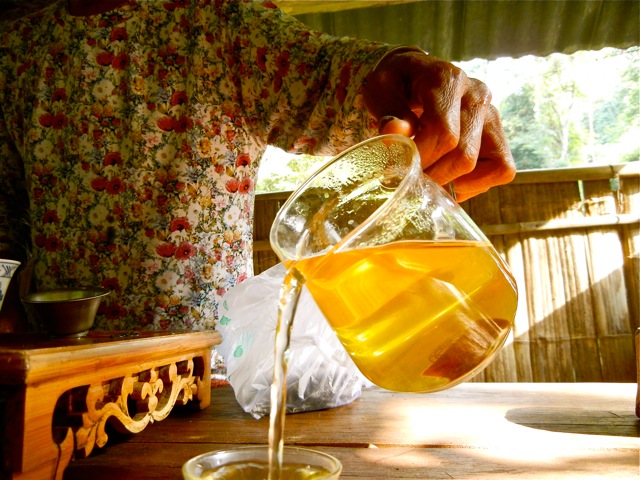
Panacea for all things, the offer of tea and the cup itself is one of the rewards for the journey to any tea sanctuary
Fortunately (or unfortunately depending on who has been touched by these classics) these teas are rare and to complicate the matter, rarer still due to the sacrilegious legions of ‘fake’ old tea tree tea touted on domestic markets.
Pai and her home emanate a deep silence and it seems that anything beyond a murmur will shatter this tea sanctum. Pai herself is ghosting around through beams of sunlight that cut through the wooden walls.
As with all things tea in life, one must go to the source, (if at all possible) to ensure that one does in fact get to sample something of the divine. And so, I have returned again to Nannuo Mountain, not only to debauch on amounts consumed but also to access the forests – the ancient tea forests – that provide this nectar.
With my tea need temporarily sated, and Pai eager to move before the heat notches up yet again, we head south and up along paths that have been worn by a thousand seasons of harvester’s feet.
Valleys give way to lush damp forests that swelter. Harvesters avoid the mid-day sun, preferring the silent mornings when the sun’s rays have yet to stimulate the tea leaves’ delicate pigments. Pai is singing and humming along, often pointing out a path she used as a child to access a particular tea patch. Cicadas and their eerie songs and the odd ‘hoo-hooing’ of monkeys create a soundtrack of the rippling green forests.
The day is windless and smells at times of rotting fruit as papaya, banana and other sub-tropical trees spill their ripe goods onto the furnace floor of forest. Rows of neat tea bushes, some only a couple of years old stand in a rigid kind of anarchy, like slightly misbehaving statues. After less than forty minutes though, we are following a ragged pathway that wanders up in right angle switchbacks. We are heading into the ‘gu shu’ (ancient trees) part of the mountains.
Looking up from the maze of a pathway I look up at a forest that has changed its shape. Gone are the razor straight bamboo trees with their geometric appeal. What has taken over the quiet forest are muscular shaped trees that seem ungainly and stoic with large green leaves tapering their ends…tea leaves. A suitable hush ensues, where sounds have all muffled. Tea and its ancient force are the lords of the space.
Pai, walks with the kind of resigned ease of a local, and tells me that these ‘youthful’ specimens are ‘only’ a few hundred years old, even though they would (and do) qualify as ancient. Nannuo Mountain is more a series of mountains, hills and villages covering a huge area than a single bulky form. Teas from Nannuo Mountain are as varied as teas from entirely different regions, counties and prefectures are. Picking and harvesting a tea is one thing, production and post-picking treatment another. In order that a tea reaches its potential weather, harvester and producer all must be in concert.
What the buyer/seller/addict will look for and what locals will tell one to look for in an ancient tree’s tea is (for better or worse) a taste and aftertaste that is distinct and unambiguous, a taste that comes in waves and levels and never stops. Ancient tree tea will usually lack some of the potent bitter blast of a new Spring harvest, but will have a long finish with hints of what the deep root system pick up from the earth.
Tea tree roots do not spread wide but rather drive deep into the earth in a never ending plunge seeking out nutrients, and roots of an ancient tea tree can go where few other roots can.
While classic Nannuo teas like ‘Bang Ma’ and ‘Pa San’ will be coveted by drinkers of raw green Puer, a tea designated “Ancient Tea Tree” (gu shu cha), will always appeal regardless of price or source.
Stopping amid the forest Pai and I are wrapped within a sanctum of green as raw and wild as any I have seen. There is no symmetry, no regimented lines – it is the natural world’s brilliant chaos. Hulking shapes that are both archaic and understated; I stand within a world of ancient tea trees that give no hint of their abilities to conjure up a gorgeous cup of fluid.
This journey has taken us to an epicenter where few if any of man’s interferences exist. Harvesting hasn’t changed and for now at least, harvesting is still only done three times a year particularly with the ancient tree’s leaves. Small pathways lead from this forest to any number of communities tucked away. These tea forests are ‘owned’ and designated by acceptance only. There are no fences, no signs designating anything even remotely unnatural. Respect and understanding of tea’s meaning (and worth) within the communities is paramount and evidently here, still enough. The traditional ‘rules’ of verbal transmission and honour, refreshingly still mean something.
Pai leads further up still, to a point where the trickling of a stream tinkles through the air. Beside this spring-fed stream, a small fire crackles and a split log acts as a tea table. A tiny woman with strong dark features bids us to sit flashing us a wordless smile when I ask what is on the menu…she simply points a finger to the aged trees around us. Pai tells me that much of the surrounding forest is owned by her family and this little rest stop is a place that harvesters often come for their own jolt of ‘green’.
The tea that we finally sip – which is prepared without fuss or drawn out explanations of the qualities or flavours – runs through the mouth clean, lighting up the back of the mouth. The flavours last and infuse an earthy green into the sinuses. There is no need to talk of tastes, no need to impress. Here the tea is stunning and there is no reason to bluster on about it. It is often this way within the planet’s great centres of tea production – the better the tea, the less the fuss.
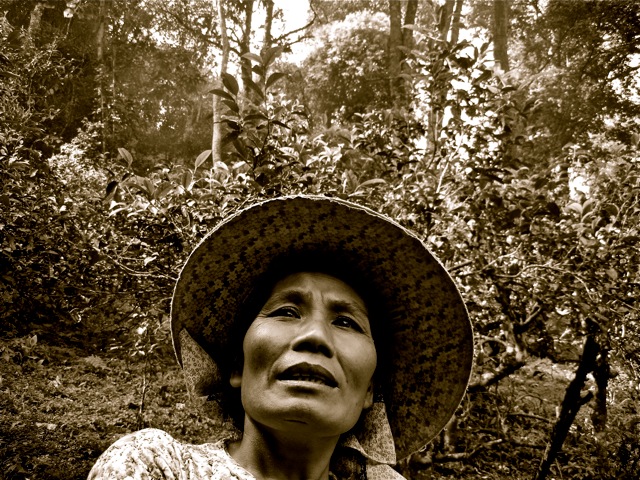
Like many of Asia's ancient traditions and secrets, tea's great tales rest in the minds and tales of elders
Walking down the mountain later in the day, Pai inadvertently (or perhaps very purposefully) states why the teas here are so coveted, so special, “they [the trees] are part of our community, like family”.

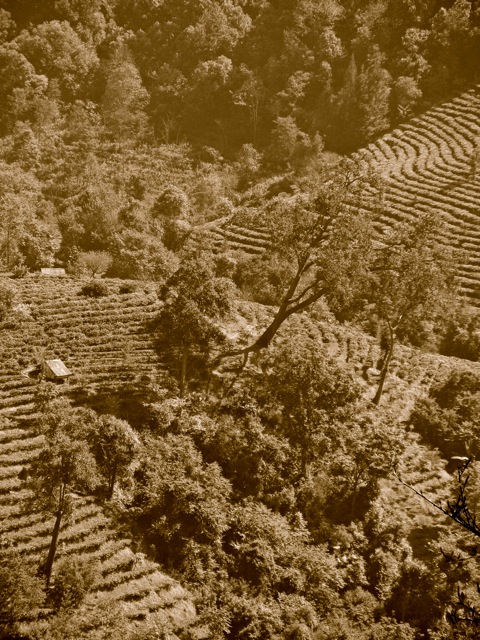
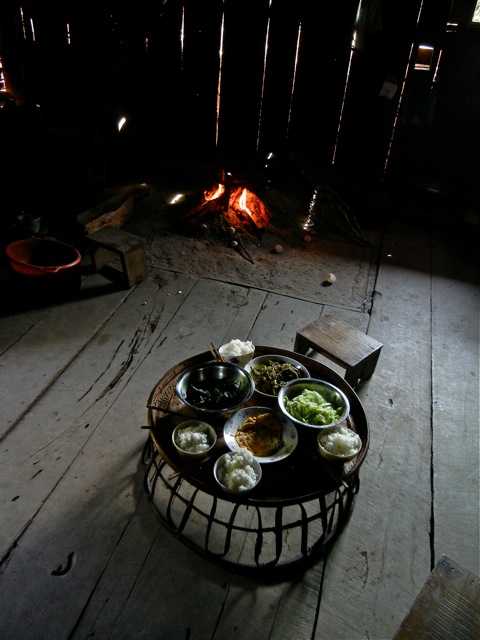
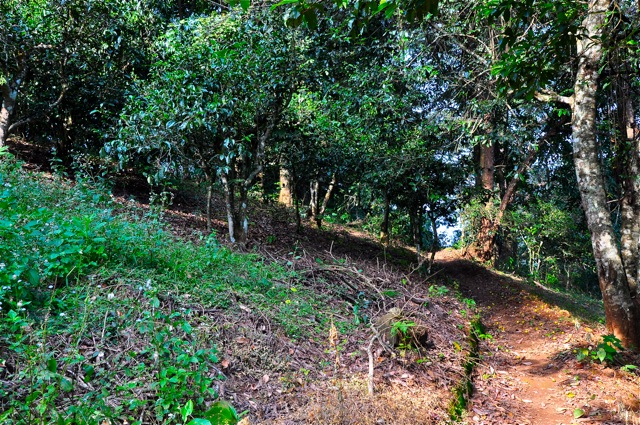
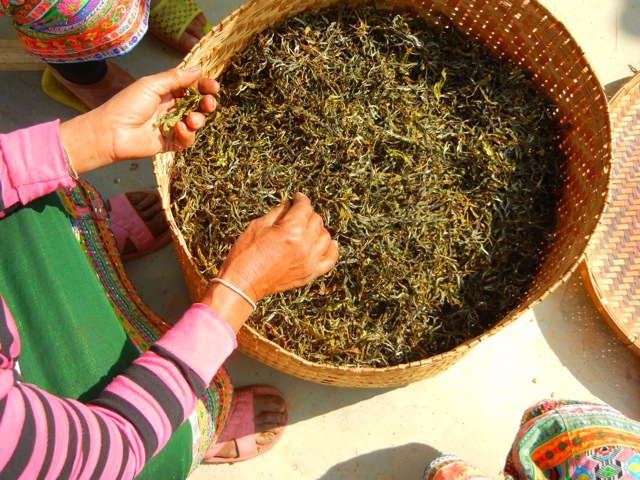
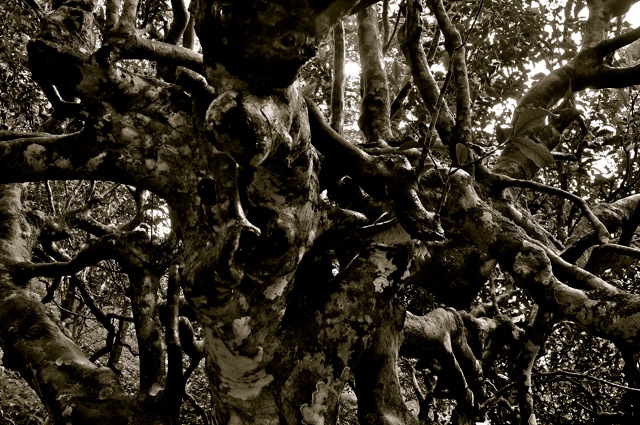
Another great piece about a rarely reported aspect of “modern” tea culture. This is why I appreciate your writings so much, Jeff, viz. telling the tales of tea which are rarely (if ever) told.
I have the impression that the newly picked leaves from these ancient trees, when brewed, taste bitter. (And this is what the locals prefer and drink themselves.) However, as time passes, the tea mellows and becomes smoother. Is this right?
Thanks.
Best wishes,
Peter
Thanks for the note back Peter. These little ‘tales from afar’ hopefully provide something with an added and crucial perspective to the whole tea arena. It is most often that these perspectives aren’t communicated – but they are after all the thoughts, facts and impressions from tea’s ancient home.
Yes, newly picked tea is packed with bitter bursts and yes, it is this ‘fresh’ tea that locals prefer. Teas mellow with time and hit their prime (for locals at least) within two years.
Once the bitterness is no longer an issue on the palate, it is something that is craved again and again.
Jeff